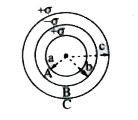There are three concentric thin spheres of radius a,b,c(a>b>c). The total surface charge densities on their surfaces are σ,−σ,σ respectively. The magnitude of the electric field at r (distance from centre) such that a>r>b is:
A. 0
B. σε0r2(b2−c2)
C. σε0r(a2+b2)
D. none of these
0
σε0r2(b2−c2)r3
σε0r(a2+b2)
none of these
The correct Answer is:B
To solve the problem, we will use Gauss's law to find the electric field at a distance r from the center of the concentric spheres.
1. Understanding the Configuration:
- We have three concentric spheres with radii a, b, and c such that a>b>c.
- The surface charge densities are σ for the sphere of radius a, −σ for the sphere of radius b, and σ for the sphere of radius c.
2. Identifying the Region:
- We need to find the electric field at a distance r from the center where b<r<a.
3. Applying Gauss's Law:
- According to Gauss's law, the electric flux through a closed surface is equal to the charge enclosed divided by ϵ0:
ΦE=∮→E⋅d→A=Qenclosedϵ0
- For a spherical Gaussian surface of radius r, the area A is 4πr2.
4. Calculating the Enclosed Charge:
- The charge enclosed by the Gaussian surface at radius r includes contributions from the spheres with radii c and b:
- Charge from sphere of radius c:
Qc=σ⋅4πc2
- Charge from sphere of radius b:
Qb=−σ⋅4πb2
- Therefore, the total charge enclosed Qenclosed is:
Qenclosed=Qc+Qb=σ⋅4πc2−σ⋅4πb2=4πσ(c2−b2)
5. Finding the Electric Field:
- Substitute Qenclosed into Gauss's law:
∮→E⋅d→A=E⋅4πr2=4πσ(c2−b2)ϵ0
- Simplifying gives:
E⋅4πr2=4πσ(c2−b2)ϵ0
- Therefore, the electric field E is:
E=σ(c2−b2)ϵ0r2
6. Final Result:
- The magnitude of the electric field at distance r from the center is:
E=σ(b2−c2)ϵ0r2
- Since b>c, we can write it as:
E=σϵ0r2(b2−c2)
Conclusion:
The correct answer is option B:
E=σϵ0r2(b2−c2)
- We have three concentric spheres with radii a, b, and c such that a>b>c.
- The surface charge densities are σ for the sphere of radius a, −σ for the sphere of radius b, and σ for the sphere of radius c.
- We need to find the electric field at a distance r from the center where b<r<a.
- According to Gauss's law, the electric flux through a closed surface is equal to the charge enclosed divided by ϵ0:
ΦE=∮→E⋅d→A=Qenclosedϵ0
- For a spherical Gaussian surface of radius r, the area A is 4πr2.
- The charge enclosed by the Gaussian surface at radius r includes contributions from the spheres with radii c and b:
- Charge from sphere of radius c:
Qc=σ⋅4πc2
- Charge from sphere of radius b:
Qb=−σ⋅4πb2
- Therefore, the total charge enclosed Qenclosed is:
Qenclosed=Qc+Qb=σ⋅4πc2−σ⋅4πb2=4πσ(c2−b2)
- Substitute Qenclosed into Gauss's law:
∮→E⋅d→A=E⋅4πr2=4πσ(c2−b2)ϵ0
- Simplifying gives:
E⋅4πr2=4πσ(c2−b2)ϵ0
- Therefore, the electric field E is:
E=σ(c2−b2)ϵ0r2
- The magnitude of the electric field at distance r from the center is:
E=σ(b2−c2)ϵ0r2
- Since b>c, we can write it as:
E=σϵ0r2(b2−c2)
The correct answer is option B:
E=σϵ0r2(b2−c2)
Topper's Solved these Questions
Similar Questions
Three concentric spherical metallic spheres A,B and C of radii a,b and c(a<b<c) have surface charge densities σ,−σ and σ respectively.
View SolutionThree concentric metallic spherical shells A,B and C of radii a,b and c(a<b<c) have surface charge densities +σ,−σand +σ respectively ,the potential of shell B is
View Solution
Knowledge Check
Three concentric spherical shells have radii a,b and c(a<b<c) and have surface charge densities σ,−sigam and σ respectively. If VA,VB and VC denote the potentials of the three shells, then for c=a+b, we have
AVC=VB=VABVC=VA≠VBCVC=VB≠VADVC≠VB≠VA
A long thin flat sheet has a uniform surface charge density σ. The magnitude of the electric field at a distance .r. from it is given by
View SolutionThree concentric metallic spherical shell A,B and C or radii a,b and c(a<b<c) have surface charge densities −σ,+σand−σ. Respectively. The potential of shel A is :
View SolutionThree concentric spherical metal shells A.B.C of radii a,b,c(c>b>a) have surface charge density +σ,−σand+σ respectively. The potential of the middle shell is σε0 times

View SolutionThree non-conducting large parallel plates have surface charge densities σ,−2σand4σ respectively as shown in the figure. The electric field at the point P is

View SolutionThree concentric spherical shells have radii a,b and c(a<b<c) and have surface charge densities σ,−σ and σ respectively. If VA,VB and VC denote the potentials of the three shells, then for c=q+b, we have
View SolutionThe magnitude of the electric field on the surface of a sphere of radius r having a uniform surface charge density σ is
View SolutionThree concentric spherical metallic shells A,B and C of radii a,b and c (a<b<c) have surface charge densities σ,−σandσ respectively.
If the potential of shell B is VB=σ∈0(anb−b+c) and the potential of shell C is VC=σ∈0(anc−bnc+c) then n is .
View Solution
